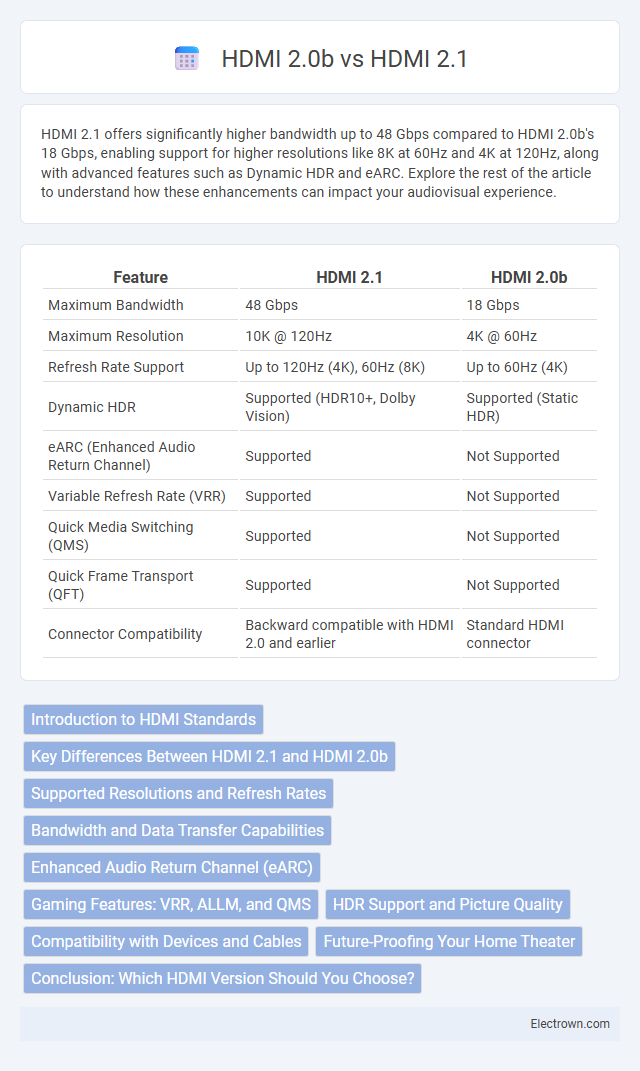HDMI 2.1 offers significantly higher bandwidth up to 48 Gbps compared to HDMI 2.0b's 18 Gbps, enabling support for higher resolutions like 8K at 60Hz and 4K at 120Hz, along with advanced features such as Dynamic HDR and eARC. Explore the rest of the article to understand how these enhancements can impact your audiovisual experience.
Table of Comparison
| Feature | HDMI 2.1 | HDMI 2.0b |
|---|---|---|
| Maximum Bandwidth | 48 Gbps | 18 Gbps |
| Maximum Resolution | 10K @ 120Hz | 4K @ 60Hz |
| Refresh Rate Support | Up to 120Hz (4K), 60Hz (8K) | Up to 60Hz (4K) |
| Dynamic HDR | Supported (HDR10+, Dolby Vision) | Supported (Static HDR) |
| eARC (Enhanced Audio Return Channel) | Supported | Not Supported |
| Variable Refresh Rate (VRR) | Supported | Not Supported |
| Quick Media Switching (QMS) | Supported | Not Supported |
| Quick Frame Transport (QFT) | Supported | Not Supported |
| Connector Compatibility | Backward compatible with HDMI 2.0 and earlier | Standard HDMI connector |
Introduction to HDMI Standards
HDMI 2.1 significantly enhances bandwidth capacity to 48 Gbps compared to HDMI 2.0b's 18 Gbps, enabling higher resolutions and faster refresh rates such as 4K at 120Hz and 8K at 60Hz. This upgrade supports dynamic HDR formats, improved audio return channel (eARC), and variable refresh rate (VRR), optimizing your home entertainment experience. HDMI 2.1's advanced features ensure compatibility with the latest gaming consoles and high-end TVs, providing superior performance over HDMI 2.0b.
Key Differences Between HDMI 2.1 and HDMI 2.0b
HDMI 2.1 supports higher bandwidth up to 48 Gbps compared to HDMI 2.0b's 18 Gbps, enabling 8K resolution at 60Hz and 4K at 120Hz, while HDMI 2.0b maxes out at 4K 60Hz. Dynamic HDR and enhanced audio return channel (eARC) are key features introduced with HDMI 2.1, providing richer color and improved audio experience. HDMI 2.1 also includes Variable Refresh Rate (VRR) and Quick Frame Transport (QFT), enhancing gaming performance and reducing latency compared to HDMI 2.0b.
Supported Resolutions and Refresh Rates
HDMI 2.1 supports resolutions up to 10K and refresh rates up to 120Hz, including 4K at 120Hz and 8K at 60Hz, providing a significant upgrade over HDMI 2.0b's maximum of 4K at 60Hz. The increased bandwidth of HDMI 2.1 enables smoother motion and enhanced detail for gaming and high-definition video playback. You will notice improved performance and future-proofing for high-resolution displays with HDMI 2.1 compared to HDMI 2.0b.
Bandwidth and Data Transfer Capabilities
HDMI 2.1 significantly increases bandwidth up to 48 Gbps compared to HDMI 2.0b's 18 Gbps, enabling higher data transfer rates for advanced audio and video signals. This enhanced bandwidth supports resolutions up to 10K, higher refresh rates, and features like Dynamic HDR and eARC. HDMI 2.1's improved data transfer capabilities provide smoother, more detailed visuals and audio for high-performance gaming and home entertainment systems.
Enhanced Audio Return Channel (eARC)
HDMI 2.1 introduces Enhanced Audio Return Channel (eARC), significantly improving audio bandwidth and supporting high-quality formats like Dolby Atmos and DTS:X compared to HDMI 2.0b. This enables Your home entertainment system to deliver lossless, high-resolution audio directly from the TV to an AV receiver or soundbar without compression. eARC also simplifies connectivity by ensuring automatic device discovery and lip-sync correction, enhancing the overall audio-visual experience.
Gaming Features: VRR, ALLM, and QMS
HDMI 2.1 significantly enhances gaming experiences by supporting Variable Refresh Rate (VRR), Auto Low Latency Mode (ALLM), and Quick Media Switching (QMS), features absent or limited in HDMI 2.0b. VRR reduces screen tearing and stuttering by synchronizing the display's refresh rate with the GPU's frame rate, while ALLM automatically switches the display to low latency mode for smoother gameplay. QMS eliminates the delay when switching between different frame rates, ensuring seamless transitions in gaming and video content.
HDR Support and Picture Quality
HDMI 2.1 significantly enhances HDR support by enabling dynamic HDR formats like HDR10+ and Dolby Vision, delivering superior picture quality with improved contrast and color accuracy compared to HDMI 2.0b's static HDR capabilities. The increased bandwidth of HDMI 2.1 supports higher resolutions and frame rates, allowing your display to showcase more vibrant and detailed images. For users seeking the best visual experience, HDMI 2.1 provides noticeable improvements in HDR performance and overall picture fidelity.
Compatibility with Devices and Cables
HDMI 2.1 supports higher bandwidth up to 48 Gbps, enabling compatibility with advanced devices like 8K TVs, gaming consoles, and VR headsets that require Ultra High-Speed HDMI cables. HDMI 2.0b offers up to 18 Gbps bandwidth, suitable for 4K resolution at 60Hz and older devices using High-Speed HDMI cables. Using HDMI 2.1 cables ensures backward compatibility with HDMI 2.0b devices, but HDMI 2.0b cables may limit performance when connected to HDMI 2.1 ports.
Future-Proofing Your Home Theater
HDMI 2.1 supports higher bandwidth up to 48 Gbps, enabling 8K resolution at 60Hz and 4K at 120Hz, making it essential for future-proofing home theaters. It also introduces Dynamic HDR, eARC for enhanced audio return channel, and variable refresh rate (VRR) for smoother gaming experiences. HDMI 2.0b maxes out at 18 Gbps, supporting 4K at 60Hz, which limits its capability for upcoming high-resolution content and advanced audio formats.
Conclusion: Which HDMI Version Should You Choose?
HDMI 2.1 supports higher resolutions up to 10K, 48 Gbps bandwidth, and features like variable refresh rate (VRR) and enhanced audio return channel (eARC), making it ideal for future-proofing and high-end gaming or home theater setups. HDMI 2.0b offers 18 Gbps bandwidth and supports 4K at 60Hz, suitable for most current TVs and devices without requiring the latest enhancements. Choose HDMI 2.1 for cutting-edge performance and compatibility with advanced media formats, while HDMI 2.0b remains sufficient for standard 4K usage and budget-conscious setups.
HDMI 2.1 vs HDMI 2.0b Infographic

 electrown.com
electrown.com